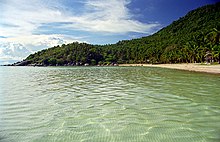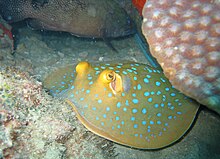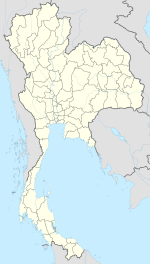Ko Tao
Ko Tao
เกาะเต่า | |
|---|---|
 Shark Bay, on the island's south side | |
| Coordinates: 10°5′24″N 99°50′17″E / 10.09000°N 99.83806°E | |
| Country | Thailand |
| Province | Surat Thani |
| Area | |
| • Total | 21 km2 (8 sq mi) |
| Population | |
| • Total | 1,382 |
| Time zone | UTC+7 (ICT) |
Ko Tao (also often Koh Tao, Thai: เกาะเต่า, Thai pronunciation: [kɔ̀ʔ tàw], lit. "Turtle Island") is an island in Thailand and forms part of the Chumphon Archipelago on the western shore of the Gulf of Thailand. It covers an area of about 21 km². Administratively it forms a district (amphoe) (as of 2013[update]) of Surat Thani Province. As of 2006[update] its official population was 1,382.[citation needed] The main settlement is Ban Mae Hat.
The economy of the island is almost exclusively centred on tourism, especially scuba diving.
History
Initially[when?] the island was uninhabited, with only the occasional fisherman from the neighbouring islands, looking for shelter in a storm or just resting before continuing on his journey.
It would appear from old maps and descriptions that this island was known by European cartographers and mariners as "Pulo Bardia", indicating that it was first settled by Malayo-Polynesian peoples. The old maps show a chain of three islands aligned north-south and lying off the east coast of the Malay Peninsula. The most northerly and smallest of these islands is marked P. Bardia, the name it had until the early 1900s. The best map example is by John Thornton from The English Pilot, the Third Book, dated 1701, but the specific map of the Gulf of Siam is dated around 1677.[1] Also see maps of the East Indies by William Dampier c.1697.[citation needed] By modern standards of accuracy, the islands are poorly placed on early maps. Seventeenth century marine navigation and cartography used the "backstaff" which, in this area, was accurate to one degree of longitude, or around 60 nautical miles.
The Edinburgh Gazetteer, or Geographical Dictionary published in 1827 also mentions the island and provides a geographical position.[2] In his 1852 book titled Narrative of a Residence in Siam. by Frederick Arthur Neale, the author describes the people and wildlife of Bardia. According to the account there were farms and even cows in a village on the bay lying on the west side of the island. The book includes a fanciful illustration of "Bardia" showing huts and palm trees.[3]
Joseph Huddart in 1801 included these directions for navigating the islands, "To the N.W. by N are two islands of about the same height as Poolo Carnom [Ko Samui]; the first, called SANCORY [Ko Pha Ngan], is 7 leagues from Carnom; the other...,named BARDA, or Bardia [Ko Tao], is 7½ leagues from Sancory."[4] (A league is approximately 3 nautical miles or 5.5 km.)
On 18 June 1899, King Chulalongkorn visited Ko Tao and left as evidence his monogram on a huge boulder at Jor Por Ror Bay next to Sairee Beach. This place is still worshipped today.[by whom?]
In 1933 the island started to be used as a political prison. In 1947 Khuang Abhaiwongse, prime minister at that time, pleaded and received a royal pardon for all prisoners on the island. Everybody was taken to the shore of Surat Thani and Ko Tao was abandoned again.
In the same year Khun Uaem and his brother Khun Oh reached Ko Tao from the neighbouring Ko Pha Ngan by trying out their traditional sail boat, for that time a quite long and dangerous journey. Even though the island was still under royal patronage, it did not stop these pioneers claiming themselves a good part of the land on today's Sairee Beach. Having brought their families over, they began to cultivate the excellent soil, forming the first generation of the present-day community. They lived a simple and tough life harvesting coconuts, fishing, and growing vegetables, which were also traded with Ko Pha Ngan. Despite the difficulties in reaching the island, the population grew steadily.
In the 1980s overseas travellers began to visit Ko Tao and quickly became a popular destination. As a consequence, bigger, faster and safer boats were used to allow easier access to Ko Tao. In the 1990s the island became known as a diving site.
Environment
The island is an important breeding ground for hawksbill and green turtles. The development of tourism has negatively impacted the health of these grounds, but a breeding programme organised in 2004 by the Royal Thai Navy and KT-DOC, a coalition of local scuba diving centres, has reintroduced hundreds of juvenile turtles to the island's ecosystem.
Chumpon Pinnacle, a dive site to the west of the island has a reputation for divers in search of both whale sharks and bull sharks. However, because of warmer water temperatures over the last year a great number of bull sharks have migrated to cooler waters. The island is host to over 130 species of hard corals, and over 223 species of reef fishes belonging to 53 families.[5]
Diving conditions have improved dramatically in the past few years with the continuing education of locals by the dive community. El Niño weather patterns caused a warming of the waters which resulted in the loss of a great deal of the shallow corals near the island. Since then, the recovery has been swift and dramatic. Ko Tao now offers some of the best scuba diving in the Gulf of Thailand.[6] And with help by island conservation group, Save Koh Tao, the island's environmental outlook is improving.[7]
As one of the world's most popular diving destinations, more attention is being focused on the negative effects of diving on coral reef health around Ko Tao.[8] Natural factors combined with over-use of some areas has led to an increase in the abundance of corallivores such as Drupella snails[9] and the crown-of-thorns starfish[10] around the island in recent years. In 2012, a Marine Zoning and Regulations Master Plan was developed for the island and subsequently become local law, but the positive effects of increased management have yet to be realized.[11]
Tourism and development on the island has grown steadily for the last several decades, with public infrastructure often lagging far behind. Shortages of electricity and fresh water[12] are common, and both solid and liquid waste management is inadequate.[13]
Tourism



The island is well known for scuba diving and snorkeling, as well as hiking, rock climbing, and bouldering. The most popular place for tourists is Sairee on the west coast, which has a white sandy beach of 1.7 km interrupted only by a few huge boulders and a scattering of medium budget resorts and restaurants. Chalok Baan Khao, to the south of the island, is becoming increasingly popular as an alternative for those wishing to escape the crowds. A great many granite boulders, both in the forests and on the beaches of Ko Tao, attract a growing number of climbers.
Ko Tao is less developed than Ko Samui and Ko Pha Ngan, but has become increasingly popular especially with the mid-20s backpacker crowd in search of relatively inexpensive scuba diving certification. For the past two years the demographics of the island has seen an age increase, with many of the visitors who first visited the island over ten years ago are now returning with their families.
A series of tourist deaths — including murder and suicide — particularly since 2014, has prompted some to advise that tourists avoid visiting Ko Tao.[14][15] However heightened media coverage of recent tragedies on Ko Tao may have given the impression that the island is far more dangerous than it actually is. Compared to other areas of Thailand, Ko Tao appears to be relatively safe.[16]
Population
Due to increasing tourism, 3,000–5,000 Burmese workers staff the island.[17] Burmese have the advantage of competent English due to the legacy of British rule in their country. There is a dominant Thai family on the island that owns several dive schools, resorts and bars.[18]
Transportation

Roads are basic and generally in poor shape. Motorbikes are the main form of transport, however visitors are advised to drive responsibly as motorbikes are the main cause of injury to tourists in the area. Tourists are advised not to give their passports when renting scooters and motorbikes as they may be taken advantage of when returning bikes and being forced to pay for non-existent or grossly exaggerated damages to the rented scooters and motorbikes.
Ferries
Ferry companies Lomprayah, Seatran, and Songserm serve Ko Tao from:
- Surat Thani (4 hours day boat, 9 hours on overnight boat)
- Chumphon (1.5–3 hours, 7 hours on overnight boat)
- Ko Samui (approximately 2.5 hours)
- Ko Pha Ngan (approximately 1.5-2 hour).
All ferries dock at Ban Mae Haad. Journey times vary due to the different boats used by the various ferry companies.
Air
Ko Tao has no airport, but connections to high speed catamarans and ferries are available at 3 airports.
- Chumphon Airport (CJM)
- Ko Samui Airport (USM)
- Surat Thani Airport (URT)
Rail
Train services are available to Chumphon where travellers can then catch a ferry.
See also
References
- ^ Thornton, John. "The English Pilot, the Third Book". Royal Museums Greenwich. Archived from the original on 3 May 2012.
{{cite web}}: Unknown parameter|dead-url=ignored (|url-status=suggested) (help) - ^ The Edinburgh Gazetteer, or Geographical Dictionary:... London: Longman, Rees, Orme, Brown, and Green. 1827. p. 383. Retrieved 2015-01-04.
- ^ Neale, Frederick Arthur (1852). Narrative of a Residence in Siam. London: Office of the National Illustrated Library. p. 120.
- ^ Huddart, Joseph (1801). The Oriental Navigator; or, New DIrection for Sailing to and from the East Indies, China, New Holland, etc.,... (2nd ed.). London: Robert Laurie and James Whittle. p. 459. Retrieved 2015-01-04.
- ^ Scaps, Patrick; Chad M. Scott. "An update to the list of coral reef fishes from Koh Tao, Gulf of Thailand". CheckList. 10 (5): 1123–1133. doi:10.15560/10.5.1123.
{{cite journal}}: CS1 maint: unflagged free DOI (link) - ^ "Koh Tao". Amazing Thailand. Tourism Authority of Thailand. Retrieved 2015-01-03.
- ^ Scott, Chad M.; Wayne Phillips. "A Sustainable Model for Resource Management and Protection Achievable through Empowering Local Communities and Businesses" (PDF). Ramkhamhaeng University International Research Conference 2010. 1: 25–28.
- ^ Lamb, Joleah; James D. True; Srisakul Piromvaragorn; Bette L. Willis. "Scuba diving damage and intensity of tourist activities increases coral disease prevalence" (PDF). Biological Conservation. 178: 88–96. doi:10.1016/j.biocon.2014.06.027.
- ^ Hoeksema, Bert W.; Chad M. Scott; James D. True. "Dietary shift in corallivorous Drupella snails following a major bleaching event at Koh Tao, Gulf of Thailand". Coral Reefs. 32 (2): 423–428. doi:10.1007/s00338-012-1005-x.
- ^ Scott, Chad M.; Rahul Mehrotra; Pau Urgell. "Spawning observation of Acanthaster planci in the Gulf of Thailand". Marine Biodiversity: 1–2. doi:10.1007/s12526-014-0300-x.
- ^ Hein, Margaux; Joleah B. Lamb; Chad M. Scott; Bette L. Willis. "Assessing baseline levels of coral health in a newly established marine protected area in a global scuba diving hotspot". Marine Environmental Research. 103: 56–65. doi:10.1016/j.marenvres.2014.11.008.
- ^ Larpnun, Radda; Chad M. Scott; Pinsak Surasawadi. "Practical Coral reef management on small island: Controlling sediment on Koh Tao, Thailand" (PDF). Catchment Management and Coral Reef Conservation: A Practical Guide for Coastal Resource Managers to Reduce Damage from Catchment Areas... 178: 88–89.
- ^ Charuvastra, Teeranai (21 November 2016). "Koh Tao Alarmed by Growing Trash Pile". Khaosod English. Retrieved 21 November 2016.
- ^ Dickinson, Elaine (2017-07-05). "Thailand's Dark Side: Why You Really Shouldn't Visit Koh Tao". The Independent. Retrieved 8 October 2017.
- ^ Promchertchoo, Pichayada (2016-01-12). "Thailand's beauty 'very dangerous trap': Sister of Koh Tao victim". Channel NewsAsia. Retrieved 8 October 2017.
- ^ https://www.farang-deaths.com/statistics/[failed verification]
- ^ Campbell, Charlie (2015-07-17). "This Septic Isle: Backpackers, Bloodshed and the Secretive World of Koh Tao". Time. Retrieved 8 October 2017.
- ^ Peter Walker (2014-11-24). "Koh Tao's dark side: dangers of island where Britons were murdered". The Guardian.
External links
 Ko Tao travel guide from Wikivoyage
Ko Tao travel guide from Wikivoyage

